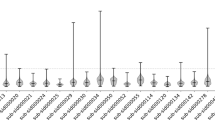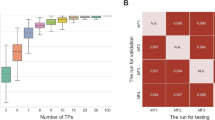Abstract
We investigate the suitability of the multi-voxel pattern analysis approach to analyze diverse movie stimulus functional magnetic resonance imaging (fMRI) data. We focus on predicting the presence of faces in the drama movie based on the fMRI measurements of 12 subjects watching the movie. We pose the prediction as a regression problem where regression coefficients estimated from the training data are used to estimate the presence of faces in the stimulus for the test data. Because the number of features (voxels) exceeds the number of training samples, an emphasis is placed on the feature selection. We compare four automatic feature selection approaches. The best results were achieved by sparse regression models. The correlations between the face presence time-course predicted from fMRI data and manual face annotations were in the range from 0.43 to 0.62 depending on the subject and pre-processing options, i.e., the prediction was successful. This suggests that proposed methods are useful in testing novel research hypotheses with natural stimulus fMRI data.
Access this chapter
Tax calculation will be finalised at checkout
Purchases are for personal use only
Preview
Unable to display preview. Download preview PDF.
Similar content being viewed by others
References
Efron, B., Hastie, T., Johnstone, I., Tibshirani, R.: Least angle regression. Annals of Statistics 32(2), 407–499 (2004)
Hanson, S.J.J., Schmidt, A.: High-resolution imaging of the fusiform face area (FFA) using multivariate non-linear classifiers shows diagnosticity for non-face categories. NeuroImage 54(2), 1715–1734 (2011)
Hastie, T., Tibshirani, R., Friedman, J.: The elements of statistical learning: Data mining, inference, and prediction. Series in Statistics. Springer, Heidelberg (2009)
Haxby, J.V., Gobbini, M.I., Furey, M.L., Ishai, A., Schouten, J.L., Pietrini, P.: Distributed and overlapping representations of faces and objects in ventral temporal cortex. Science 293(5539), 2425–2430 (2001)
Jääskeläinen, I.P., Koskentalo, K., Balk, M.H., Autti, T., Kauramäki, J., Pomren, C., Sams, M.: Inter-subject synchronization of prefrontal cortex hemodynamic activity during natural viewing. The Open Neuroimaging Journal 2, 14–19 (2008)
Kanwisher, N., McDermott, J., Chun, M.M.: The fusiform face area: a module in human extrastriate cortex specialized for face perception. J. Neurosci. 17(11), 4302–4311 (1997)
Kauppi, J.P., Jääskeläinen, I.P., Sams, M., Tohka, J.: Inter-subject correlation of brain hemodynamic responses during watching a movie: localization in space and frequency. Frontiers in Neuroinformatics 4, 5 (2010)
Lin, S.W., Lee, Z.J., Chen, S.C., Tseng, T.Y.: Parameter determination of support vector machine and feature selection using simulated annealing approach. Appl. Soft Comput. 8, 1505–1512 (2008)
Mitchell, T.M., Hutchinson, R., Niculescu, R.S., Pereira, F., Wang, X., Just, M., Newman, S.: Learning to Decode Cognitive States from Brain Images. Machine Learning 57(1), 145–175 (2004)
Norman, K., Polyn, S., Detre, G., Haxby, J.: Beyond mind-reading: multi-voxel pattern analysis of fMRI data. Trends in Cognitive Sciences 10(9), 424–430 (2006)
Sjöstrand, K.: Matlab implementation of LASSO, LARS, the elastic net and SPCA (2005), http://www2.imm.dtu.dk/pubdb/p.php?3897
Smith, S.M., et al.: Advances in functional and structural MR image analysis and implementation as FSL. NeuroImage 23(suppl. 1), S208–S219 (2004)
Spiers, H., Maguire, E.: Decoding human brain activity during real-world experiences. Trends in Cognitive Sciences 11(8), 356–365 (2007)
Tibshirani, R.: Regression Shrinkage and Selection Via the Lasso. Journal of the Royal Statistical Society, Series B 58, 267–288 (1994)
Author information
Authors and Affiliations
Editor information
Editors and Affiliations
Rights and permissions
Copyright information
© 2011 Springer-Verlag Berlin Heidelberg
About this paper
Cite this paper
Kauppi, JP., Huttunen, H., Korkala, H., Jääskeläinen, I.P., Sams, M., Tohka, J. (2011). Face Prediction from fMRI Data during Movie Stimulus: Strategies for Feature Selection. In: Honkela, T., Duch, W., Girolami, M., Kaski, S. (eds) Artificial Neural Networks and Machine Learning – ICANN 2011. ICANN 2011. Lecture Notes in Computer Science, vol 6792. Springer, Berlin, Heidelberg. https://doi.org/10.1007/978-3-642-21738-8_25
Download citation
DOI: https://doi.org/10.1007/978-3-642-21738-8_25
Publisher Name: Springer, Berlin, Heidelberg
Print ISBN: 978-3-642-21737-1
Online ISBN: 978-3-642-21738-8
eBook Packages: Computer ScienceComputer Science (R0)




